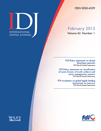Oral cancer in India continues in epidemic proportions: evidence base and policy initiatives
Abstract
Objectives
India has the highest number of cases of oral cancer in the world and this is increasing. This burden is not fully appreciated even within India, despite the high incidence and poor survival associated with this disease. Because the aetiology of oral cancer is predominantly tobacco-related, the immense public health challenge can be meliorated through habit intervention.
Methods
We reviewed current rates of incidence, mortality and survival, and investigated the determinants of disease and current prevention strategies.
Results
In addition to tobacco smoking and the myriad other forms of tobacco use prevalent in India, risk factors include areca nut consumption, alcohol consumption, human papillomavirus, increasing age, male gender and socioeconomic factors. Although India has world-leading cancer treatment centres, access to these is limited. Further, the focus of health care services remains clinical and is either curative or palliative.
Conclusions
Although the efforts of agencies such as the Ministry of Health and Family Welfare and the Indian Dental Association are laudable, enhanced strategies should be based on common risk factors, focusing on primary prevention, health education, early detection and the earliest possible therapeutic intervention. A multi-agency approach is required.
The Indian subcontinent, especially India itself because of its large population, has long been regarded as the global epicentre of oral cancer. The malady recognised by the world as oral cancer was first described in the Sushruta Samhita, a treatise on Indian surgery written in Sanskrit around 600 BC1. The World Health Organization (WHO) regards oral cancer as a major public health challenge in India2. The burden it imposes, in terms of incidence, mortality, survival and the determinants of disease, as well as the inevitable stretching of limited health care resources, is not fully appreciated, particularly in India. There is wide variation in the global burden of this disease, with incidences in India and across South and Southeast Asia amongst the highest in the world3. Incidence is also increasing elsewhere, such as in parts of Western and Eastern Europe, Latin America and the Pacific regions3.
Malignant neoplasms of the lip, oral cavity and oropharynx [International Classification of Diseases (ICD)-10 codes: C00–C14], excluding other pharyngeal sites (C11–C13), are often grouped together4. They have common risk factors and, to some extent, behaviours. Collectively, these conditions represent the sixth most common type of cancer in the world. Annual estimated global incidences amount to around 275,000 cases of oral and 130,300 cases of pharyngeal cancers excluding cancers of the nasopharynx, two thirds of which occur in developing countries5. In this paper, we define oral cancer as any malignant neoplasm occurring on the lips or within the mouth/oral cavity, including on the tongue (ICD-10 codes: C00–C06)6. Wherever possible, we have excluded diseases of the major salivary glands (C07, C08) and nasopharynx (C11) because of their different biology4. Diseases of the oropharynx (C10), pyriform sinus (C12) and hypopharynx (C13) have some commonality in risk factors and behaviour and therefore data for disease in these sites are given where relevant. Because of inconsistencies in the groupings used by different authors and databases, we have striven to list the sites included whenever data are given.
Today, 90–95% of all new cases of oral malignancy in most populations, including that in India, are squamous cell carcinomas (SCC) arising from lining mucosa7. Squamous cell carcinomas of the oro- and hypopharynx are increasing in many countries, particularly in the West. Many cases are related to the traditional risk factors of smoking and heavy alcohol consumption, and others to infection with human papillomavirus (HPV). However, in the Indian context, oral cancer itself is most common, and its aetiology is dominated by tobacco use, especially of smokeless tobacco, areca [betel] nut consumption and alcohol abuse, all of which frequently act in the presence of poor diet and poor dental health. This is a preventable disease: this paper focuses on the public health challenge presented by oral cancer in India.
Materials and methods
Search strategy
Our extensive literature review screened the PubMed, EMBASE, CINAHL (Cumulative Index to Nursing and Allied Health Literature), Cochrane Library and Cochrane Oral Health Group's Trials Register databases up to October 2011 for literature published in English only, irrespective of publication date. Main search terms were: ‘oral cancer’; ‘mouth cancer’; ‘risk factors’; ‘policy’; ‘interventions’ and ‘treatment’, with ‘India’. Supplementary key words were: ‘tobacco’; ‘alcohol’; ‘betel nut’; ‘areca nut chewing’; ‘socioeconomic determinants’; ‘oral cancer epidemiology’; ‘oral cancer prevention’, and ‘oral cancer treatment’. A total of 793 articles were retrieved, for which the titles and abstracts were evaluated. This resulted in the retention of 131 articles which were read in full; 32 of these were excluded for not reporting relevant outcomes.
The ‘related articles’ links and the references of the articles reviewed were hand-searched for additional references. This resulted in the identification of a further 140 papers.
Papers excluded were those in which some confusion over the anatomical sites of origin of the malignancies described was apparent, papers in which the numbers of cases were small and the data were judged to be not generalisable, and papers reporting studies in which the analytical methods were judged to be faulty. A total of 99 papers were fully evaluated. The most relevant data were found in official publications of the Indian Council of Medical Research (ICMR), derived from the individual registries maintained across the nation (Figure 1). We reviewed the following databases and websites: GLOBOCAN 2008; National Centre for Disease Informatics and Research (http://www.ncdirindia.org/); National Cancer Registry Programme (http://www.icmr.nic.in/ncrp/cancer_reg.htm); International Agency for Research on Cancer (IARC) (http://www.iarc.fr/); International Head and Neck Epidemiology (http://inhance.iarc.fr/index.php); Centers for Disease Control and Prevention (http://www.cdc.gov), and the IARC Screening Group (http://screening.iarc.fr/atlasoral.php?lang-1). We also reviewed the textbooks Head and Neck Cancer: Multimodality Management (Bernier J, ed., Springer/Humana Press, 2011) and Oral Cancer (Shah JP, Johnson NW, Batsakis JG, eds., Martin Dunitz, 2003).
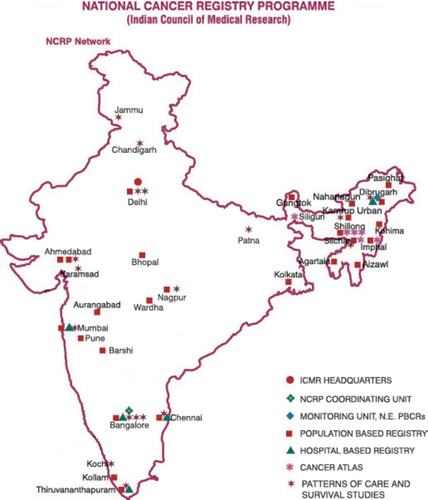
Results
Descriptive epidemiology
Global burden of oral cancer
Estimated incidence, mortality and 5-year prevalences of lip and oral cavity cancer, as estimated by GLOBOCAN 2008, for the whole world and for India, are summarised in Table 1. Two thirds of the global burden of these cancers occurs in developing countries and the Indian subcontinent accounts for nearly one third of global incidence8.
| Population | World | More developed regions | Less developed regions | South Central Asia | India |
|---|---|---|---|---|---|
| Incidence | |||||
| Cases, n* | 263,020 | 91,148 | 171,872 | 97,623 | 69,820 |
| ASR-w, %† | 3.8 | 4.4 | 3.6 | 7.4 | 7.5 |
| Cumulative risk, %‡ | 0.44 | 0.51 | 0.42 | 0.88 | 0.89 |
| Mortality | |||||
| Cases, n* | 127,654 | 30,689 | 96,965 | 63,610 | 47,653 |
| ASR-w, %† | 1.8 | 1.4 | 2.0 | 4.9 | 5.2 |
| Cumulative risk, %‡ | 0.22 | 0.16 | 0.24 | 0.59 | 0.61 |
| 5-year prevalence | 610,656 | 258,973 | 351,683 | 172,534 | 107,690 |
- *Crude rates are expressed as the annual rate per 100,000 persons at risk.
- †Weighted age-standardised rates (ASR-w) are expressed as rates per 100,000 population.
- ‡Cumulative risk for age (0–74 years), %.
- Data are derived from GLOBOCAN 2008 (http://globocan.iarc.fr/).
Although the incidence rates given for oral cancer for all ages (0–75 years) are lower in India [weighted age-standardised rate (ASR-w) for both sexes combined: 7.5 per 100,000 per annum] than in some other developing countries, notably Melanesia (ASR-w 17.8), Maldives, Taiwan, Brunei and Sri Lanka, India contributes the highest number of new cases because of its huge population. Over five people die from oral cancer every hour every day in India and almost the same number die from cancer of the oropharynx and hypopharynx3.
Burden of oral cancer in India
Oral cancer (ICD-10 codes: C01–C06) ranks amongst the three most common cancers in India and in some areas accounts for almost 40% of total cancer deaths9. Figure 2 shows estimated incidences and mortality in men and women of all ages in India. Approximately 70,000 new cases and more than 48,000 oral cancer-related deaths occur yearly10. In most regions of India, oral cancer is the second most common malignancy diagnosed in men, accounting for up to 20% of cancers, and the fourth most common in women (Figure 3)3, 11.
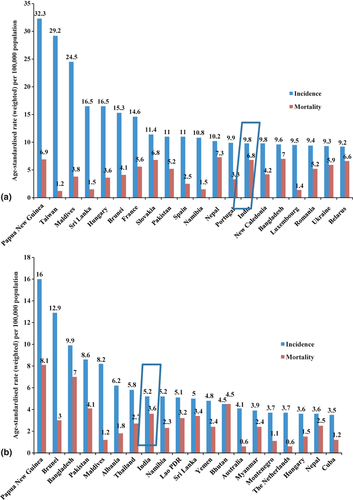
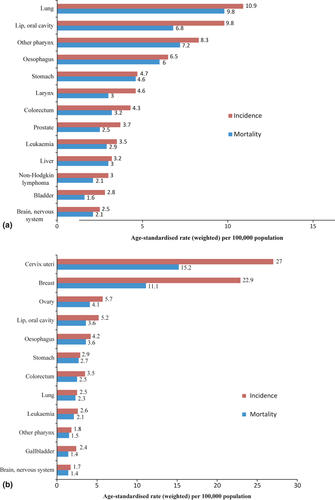
Note, however, that GLOBOCAN data for India as a whole are extrapolations based on the estimated population of the nation and data from regional cancer registries. As will become evident in this text, there is considerable variation among registries in the cases recorded. Further, as cancer registration is not compulsory in India, it is probable that the true incidence and mortality are much higher: many cases go unrecorded and/or are lost to follow-up12.
Over 100,000 cases of oral cancer are currently recorded on cancer registers across India3. The overall incidence derived from Indian databases may be as high as 19 per 100,000 per annum3, 13. According to the National Cancer Registry Programme (NCRP), Bhopal district has the highest age-adjusted incidence rate (AAR) in the world for cancers of both the tongue (ICD-10 codes: C01, C02) (10.9 per 100,000) and mouth (ICD-10 codes: C03–C06) (9.6 per 100,000) among males (Figure 4). Among females, Bhopal has the second highest AAR (7.2 per 100,000) for cancer of the mouth (Figure 4)14. Data on the AAR of tongue cancer amongst females are very scarce.
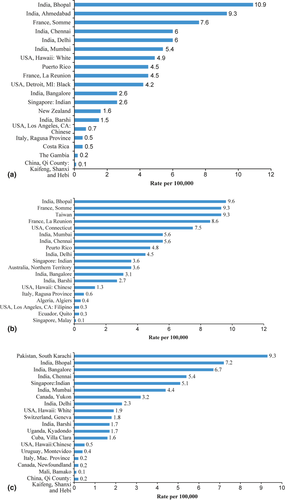
Projected burden of oral cancer in India by 2020
Numbers of oral cancer cases (IDC-10 codes: C00–C08) and deaths in India predicted by the ICMR by the year 2020 are presented in Figure 515. This substantial rise places a severe burden on the nation. The cumulative lifetime risk for mortality from lip or oral cavity cancer in India for males and females aged 0–74 years is 61%3.
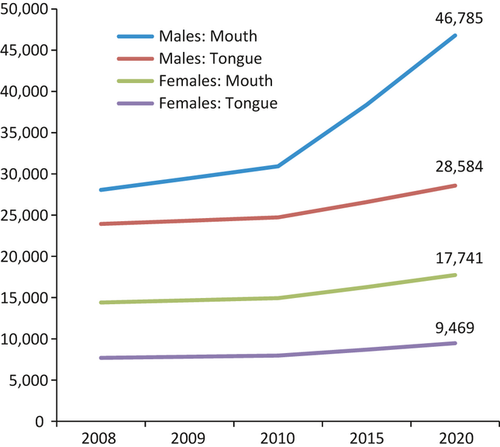
Survival
Survival for each cancer site (all clinical stages included) is described in terms of 5-year age-standardised relative survival16. In most parts of the world, mean overall 5-year survival rates in oral cancer are still hovering around 50% and rates in India are estimated to be 40–45%17. Metastasis to regional lymph nodes is the single most important prognostic factor in predicting local and distant failure, as well as survival. Significantly, 10–30% of patients with oral cancer subsequently develop second primary tumours of the aerodigestive tract18.
Marked differences in survival have been noted among rural (Barshi), semi-urban (Karunagappally) and small urban (Bhopal) registries in India, whereas differences are small between the registries of the major cities of Chennai and Mumbai, where more developed and accessible health care services are available16. Poor survival rates can also be attributed to the fact that half of the oral cancer cases in the nation are diagnosed at advanced stages (stages III and IV) because patient's delay in seeking medical care and acceptance of treatment is low5, 19.
Multiple treatment options are available in many centres. These include surgery or radiotherapy alone, and surgery with radiotherapy, with or without adjunctive chemotherapy. All of these cause tremendous physical, emotional and psychosocial disruption, but significantly worse health-related quality of life is experienced by patients who require both surgery and radiotherapy20-22. Although adjunctive chemotherapy can lengthen survival, it is associated with considerable toxicity and uniformly effective agents and regimes have yet to be identified.
Analytic epidemiology
Aetiology
The causes of malignant transformation of the oral epithelium and the processes of invasion and metastasis are as complex as for any other anatomical site. Genetic predisposition plays a minor role expressed through polymorphisms in carcinogen-metabolising enzymes, the expression of oncogenes and oncosuppressor genes, and DNA repair genes23. There is increasing evidence of the importance of chronic inflammation, alterations in host immunity, metabolism and neo-angiogenesis, all of which may be triggered or enhanced by viruses, radiation, chemicals (notably from tobacco and alcoholic beverages), hormones, nutrients or physical irritants24.
Oral potentially malignant disorders
In South Asia, the majority of oral cancers arise from pre-existing longstanding lesions, now termed ‘oral potentially malignant disorders’ (OPMDs)23 in recognition of the fact that systemic, cellular and molecular changes are much wider than any particular macroscopically visible oral lesion. In India, tobacco is the major aetiological agent, producing visible lesions of which so-called leukoplakia is the most common. This association has led to the aphorism ‘cancer is where tobacco is’25. This knowledge explains the focus for the primary prevention of oral cancer on population-based strategies and on the early detection of OPMDs; habit intervention and follow-up are regarded as secondary prevention strategies conducted on an individual basis.
Major risk factors
Risk factors may vary for different cultural and socioeconomic groups. However, established risk factors for oral cancer in the Indian population include: tobacco in all its forms (smoked, chewed, used as oral snuff); the chewing of betel quid (pan/paan); the heavy consumption of alcohol, and the presence of an OPMD24, 26. Other contributory or predisposing factors include dietary deficiencies, particularly of vitamins A, C and E and iron, and viral infections, particularly by those HPVs of known high oncogenic potential24.
Age distribution
Age-specific incidence and mortality rates of oral cavity cancer in India are illustrated in Figure 6. Although oral cancer has traditionally been thought of as a disease mainly affecting people of older ages, a substantial proportion of cases arise in the third and fourth decades of life.
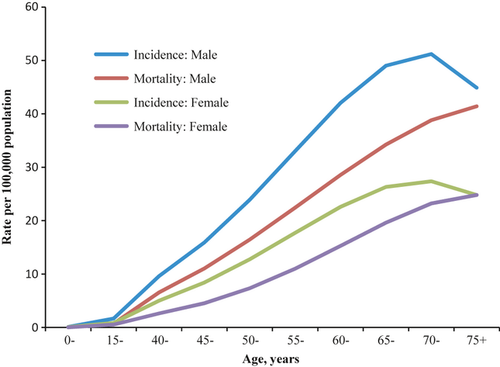
Increasing incidence with age has generally been attributed to indiscriminate substance abuse, particularly of tobacco and tobacco-related products, over a considerable period of time11, which allows multiple genetic damage to accrue. Further, immune surveillance diminishes with age27. In the West, the rising incidence of oral cancers in younger age groups refers to disease of the base of tongue and oropharynx, and appears to be related to HPV infection. However, in high-incidence countries, such as India, high tobacco consumption that begins at a relatively young age undoubtedly contributes5, 11.
Gender differences
Males are, overall, at higher risk. However, the highest incidence rates for oral cancer in the world are seen amongst some subpopulations of women in southern India, and in emigrant populations from this area, such as female plantation workers in Malaysia28. This reflects the practice of heavy pan chewing (piper betel leaf filled with sliced areca nut, lime, catechu and other spices chewed with or without tobacco), poor nutrition and poor oral hygiene. Another group of women at particular risk are those habituated to smoking with the burning end of a cheroot or cigarette held inside the mouth in the manner practised in parts of Andhra Pradesh29. This results in a high incidence of palatal cancer, which is otherwise comparatively rare.
Religion
Although Hindus carry the highest burden of oral cancer throughout India, there are no national data to explain this beyond the fact that this religious/cultural group represents the majority of the population and that many of its members are of low socioeconomic status and engage heavily in dangerous lifestyle practices30.
Tobacco
All types of tobacco are not the same: tobacco varies widely by botanical type, processing and mode of use. Unsurprisingly, it varies in toxicity, including in carcinogenicity. That said, there is no such thing as safe tobacco and, as far as is known, all forms of tobacco common in India are highly toxic to multiple body systems. There is an extensive literature on the wide range of tobacco products used in India. These are summarised, in the context of a thoughtful approach to tobacco control in India, in the Report of the Ministry of Health and Family Welfare, 200431. Tobacco use is, indeed, the single most important modifiable risk factor for oral cancer; a meta-analysis of data available worldwide has determined the relative risk (RR) for oral cancer in current smokers to be 3.43 [95% confidence interval (CI) 2.37–4.94]32. As with all environmental carcinogens, there is a dose–response relationship. Tobacco and alcohol consumption is identified as a behavioural risk factor in 75–95% of cases of oral cancer in India33.
According to the National Family Health Survey (NFHS-3) conducted in 2005–2006, in people aged 15–49 years, tobacco use is much more prevalent among men than among women; 57% of men and 11% of women use some form of tobacco. One third of men smoke cigarettes or other tobacco products34. In rural India, and amongst those of lower socioeconomic status, hand-made products such as bidis and a variety of cheroots and cigars are common.
Beedi/bidi smoking
It is estimated that over 100 million Indians smoke bidis35. The bidi represents the most popular form of tobacco and an age-old form of indigenous smoking widely practised, particularly in southern India, by people of lower socioeconomic status36, 37.
Bidis contain about 0.2–0.5 g of raw, dried and crushed tobacco flakes, naturally cured, wrapped in a temburni leaf; they deliver as much as 45–50 mg of tar, compared with the 18–28 mg delivered in an Indian factory-produced cigarette37. A three-fold increased risk for oral cancer in bidi smokers was determined by a meta-analysis of 10 case–control studies from India by Rahman et al.38 This risk is comparable with that of cigarette smokers36.
Smokeless tobacco
Smokeless tobacco is consumed predominantly by chewing it as an ingredient in pan/paan/betel quid, packaged pan masala or gutkha (a chewable tobacco containing areca nut), and mishri (a powdered tobacco rubbed on the gums as toothpaste)39. The use of smokeless tobacco is socially acceptable, especially in eastern, northern and northeastern parts of the country31. The use of new, commercially available blends of pan masala and gutkha is increasing, not only among men, but also among children, teenagers and women40. A cohort study from Kerala found that tobacco chewing increases the risk for cancers of the gum and mouth by nearly five-fold36.
Areca nut
Areca nut is the fourth most commonly used psychoactive substance in the world after caffeine, nicotine and alcohol41. It contains arecoline and 3-(methylnitrosamino) propionitrile, and lime provides reactive oxygen radicals, each of which contribute to oral carcinogenesis26. Supari, which consists of small roasted and flavoured pieces of areca nut, often prepared commercially, is popularly served to guests after meals in northern India. In northeastern parts of India, fermented areca nut called ‘tamul’ is common. In Gujarat, ‘mawa’, which consists of thin shavings of areca nut with the addition of some tobacco and slaked lime, is very commonly used by youth. Areca nut, in combination with tobacco in the form of gutka, and without tobacco in the form of pan masala, is widely available in prepackaged forms and is promoted as a safe product and even as a mouth freshener42. However, gutka is carcinogenic and areca nut in all its forms is the major cause of the potentially malignant disorder oral submucous fibrosis43. Areca nut chewing is a socially acceptable and widely practised habit amongst youth and even children, especially in Maharashtra, Gujarat and Bihar41.
Alcohol drinking
The effects of smoking and alcohol consumption on the risk for oral cancer are strongly synergestic44. In a study from south India, a multiplicative interaction between the consumption of alcohol and tobacco products, respectively, was observed to induce a 24-fold increase in risk for oral cancer45. A cohort study conducted in Kerala revealed that approximately 80% of alcohol-dependent patients smoke cigarettes29.
Human papillomavirus
Since the first report of an association of HPV with SCC in 197746, numerous studies have explored the evidence for HPV in the aetiology of oral cancer. The association is strongest for cancer of the tonsil and other parts of the oropharynx. Positivity for HPV, specifically carriage of the high-risk genotypes HPV16 and HPV18, has come to be associated with a specific subgroup of oropharyngeal SCCs that arise preferentially among individuals with no history of significant longterm consumption of tobacco and alcohol and have a favourable outcome attributable to an increased sensitivity towards radiotherapy47-49. Human papillomavirus-associated oropharyngeal cancer thus differs from other head and neck SCCs with regard to risk factors, clinical features, sensitivity to treatment and prognosis50. A multicentre study conducted in the USA has shown that patients with HPV-positive tumours have a 50–80% reduction in risk for treatment failure compared with HPV-negative patients51.
Few data are available regarding the incidence of HPV16- and 18-induced oral cancers in the Indian scenario, except some derived from studies of small sample size52. Balaram et al. reported prevalences of 42% and 47% for HPV16 and HPV18, respectively, in a study of oral cancers in Indian betel quid chewers53. The prevalence of HPV-positive cases has shown significant geographical variation: 34% of oral SCC patients were identified as HPV-positive in eastern India, compared with 67% in southern India and 15% in western India53. The literature suggests that HPV infection is relatively more common in oral SCC patients in India than in those from other countries; for example, only 23% of Japanese patients, 8–20% of American patients and 19% of Dutch patients are HPV-positive54. All such data, however, should be interpreted cautiously: the detection of virus is very technique-dependent; there is a real risk for contamination, especially where highly sensitive polymerase chain reaction methods are employed, and the presence of virus does not itself prove causality.
Discussion
Socioeconomic determinants
All over the world, oral cancer is more prevalent amongst people of low socioeconomic status, partly because tobacco use in any form is more common in these population groups and such patients do less well because they have less access to care55. Case–control studies from India reveal that lower education levels are related to increased risk for oral cancer19. Isolated studies conducted in small townships in India have shown that level of education is closely related to awareness of oral cancer and its risk factors10.
There are large gaps in current knowledge of the precise socioeconomic determinants of oral cancer. Positive changes in the social determinants of health would lead to improvements in health equity. Approaches that take into account the principles of the Ottawa Charter for Health Promotion, adopt a common risk factor and a multi-sector coordinated approach are needed.
Current interventions for oral cancer control in India
India has several world-leading cancer treatment centres and clinical services are available across the nation. Because of the high case load, exceptional experience and expertise exists in head and neck oncology in many places. However, both access to these and the facilities available – of both staff and equipment – are highly variable. Effective prevention is necessary to stem the epidemic.
The National Tobacco Control Programme, administered by the Ministry of Health and Family Welfare at the national level, is presently predominantly confined to information, education and communication campaigns, the establishment of tobacco testing laboratories to build regulatory capacity, and the mainstreaming of programme components under the National Rural Health Mission. However, these initiatives so far have low visibility56. The Report on Tobacco Control in India31, published in 2004, makes cogent recommendations to central and state governments, civil society, health professionals, international organisations and research scientists, and proposes multi-sector action. India was an early signatory, in 2004, to the Framework Convention on Tobacco Control57 and indeed represented the seventh country in the world to ratify this. However, legislation remains weak and the tobacco industry continues to have significant lobbying influence in, for example, delaying the implementation of regulations to mandate the printing of pictorial warnings on tobacco packages. State government bans against smokeless tobacco have come and gone.
The initiatives of the Indian Dental Association are commended here. Its Tobacco Intervention Initiative and S.P.O.T. (spot and prevent oral cancer trauma) centres, established under the aegis of the Oral Cancer Foundation (OCF), are admirable and will, it is hoped, be rolled out across the entire country in due course58. Synergising these with the activities of all other stakeholders will be important.
Proposed strategies for oral cancer control in India
Primary prevention, health education, early detection and the provision of the earliest possible therapeutic intervention are all essential components of an acceptable oral cancer control policy59. Such a policy should be implemented in the form of a well-administered national oral cancer control programme. It should take into consideration the large variations across Indian states in socioeconomic and sociocultural backgrounds, languages, behaviours and lifestyles. Longitudinal monitoring and evaluation of the programme would be essential.
Such a programme could be based on the Mumbai Declaration60. This proposes a 5-year action plan with specific targets for bringing down the incidence and mortality rates associated with oral cancer. It proposes a strategic alliance of many stakeholders, including individuals, communities, organisations, corporations and governments, which would deliver action through policy development and the provision of health care at individual, community and national levels. The Mumbai Declaration builds on the Crete Declaration of 200561 and a declaration agreed by the Indian Association of Oral and Maxillofacial Pathologists (IAOMP) at an international congress held in Chennai in December 2010.
Primary prevention
Primary prevention achieved by the modification of risk factors is the most cost-effective approach62. The highest priority should be given to tobacco control. Special attention should be directed towards controlling the use of smokeless tobacco, which is rapidly increasing among women and youth. Legislative measures are needed and should build on the success of such approaches to reduce smoking across much of the world. These should include: the increased taxation of all tobacco and alcohol products and the provision of targeted funding for oral cancer prevention programmes through this enhanced tax collection; the enforcement of laws on youth access to tobacco and alcohol; the prohibition of all advertising and promotional activities by the tobacco industry, and the prominent inclusion of strong pictorial warnings in existing written warnings on the labels of tobacco and alcohol products.
Culturally acceptable health promotion and awareness programmes that address the myths and misconceptions associated with cancer and related stigma should be introduced on a large scale all over the country and should be particularly targeted towards groups identified as susceptible, such as youth and women63.
The participation of non-governmental organisations, medical and dental professionals, and behavioural scientists is required in advocacy to inform political leaders and government about the expected benefits of tobacco control, the safe use of alcohol, and programmes to increase awareness of the early warning signs of oral cancer. These programmes should be embedded into a common risk factor approach for multiple health disorders rather than applied in isolation7, 10. This is consistent with the approach of the Lancet Non-Communicable Disease (NCD) Action Group and the NCD Alliance64. It is reassuring that the United Nations recognises the need for a new approach at the highest political level. The declaration from the NCD Summit held in November 2011 called for a multi-pronged campaign by governments, industry and civil society to develop, by 2013, the plans needed to curb the risk factors behind the four groups of NCDs: cardiovascular diseases; cancers; chronic respiratory diseases, and diabetes. Article 19 of the Political Declaration stipulates that member states recognise ‘…that renal, oral and eye diseases pose a major health burden for many countries and that these diseases share common risk factors and can benefit from common responses to non-communicable diseases’65. Clearly, this includes oral cancer. The political will thus demonstrated provides encouragement. The FDI World Dental Federation will be a major partner in taking these initiatives forward65.
Health promotion programmes that advocate healthy lifestyles and focus on diets rich in vegetables, fruits, fibre, milk (to some extent), antioxidants and appropriate physical activity should be protective against oral cancer66, 67. More multicentre randomised controlled trials of dietary supplementation for persons with OPMDs are required to assess the efficacy of vitamins, retinoids and carotenoids7, 68. Identification of OPMDs should be encouraged, documented and become part of routine dental examinations in all government and private clinics23.
The establishment of a database of educational materials related to oral cancer and OPMDs – for use by both professionals and the public – in the many necessary languages and applicable across all cultural groups would be helpful.
The role of HPV should be tackled in culturally acceptable health programmes promoting safe sexual practices69. These should be part of existing – and, it is hoped, expanding – social marketing campaigns for the prevention of cancer of the uterine cervix and of sexually transmitted infections, including human immunodeficiency virus (HIV). Formal links should be established with government agencies and pharmaceutical companies engaged in HPV vaccine trials for the prevention of cervical cancer to monitor potential benefits over time in reducing the incidence of head and neck cancers7.
Education campaigns are needed to raise public awareness about oral cancer and its links with tobacco and alcohol consumption. These might be effectively supported by prominent public figures from the sports and film sectors and other distinguished persons. Oral cancer victims and survivors may be valuable in such public campaigns.
Professional knowledge and behaviours
Key needs include: the promotion of instruction in controlling tobacco and alcohol use at all levels of training in dental, medical, nursing and related health care disciplines; the promotion of routine assessment of all patients for tobacco and alcohol intake by all clinical disciplines, and the promotion of training of clinicians, especially at the primary health care level, to enable them to detect oral cancer and precancerous lesions at the earliest possible stage.
Secondary prevention: screening
Screening for oral cancer by visual examination of the mouth has been researched in several countries, usually with the conclusion that it is not cost-effective. The major reason for this is the low prevalence of disease in the societies and populations studied. The case is theoretically stronger in populations in which the disease occurs at a high prevalence, such as in India. Additionally there is, in the majority of cases in India, a recognisable precursory phase. The most meaningful work to date was carried out by the Trivandrum Oral Cancer Screening Programme. This uses visual inspection with sufficient light and has demonstrated a reduction in mortality at modest cost8, 70. The sensitivity and specificity of oral visual inspection in the detection of OPMD and oral cancer by specially trained primary health care workers were 94.3% and 99.3%, respectively, and a high level of agreement between these workers and physicians was observed8, 71.
Patients in whom findings are positive should be referred to health professionals for expert clinical opinion, support with habit cessation, biopsy if indicated in the judgement of the professional, and further management24. Although the most appropriate professional workforce resides within the dental profession, others can be trained, and screening for OPMD and oral cancer should be conducted in conjunction with screening by other programmes for other cancers and infections, including HIV and other sexually transmitted diseases, as recommended by the ‘Closing the Cancer Divide’72 report and endorsed by an editorial published recently in the Lancet72.
Access to care: tertiary prevention
Survival rates, especially in patients with advanced oral cancer at diagnosis, have changed little over recent decades, except in the most advanced high-volume centres in the world. Facilities for accurate staging, including advanced imaging, and experienced multidisciplinary teams can improve longterm survival and quality of life7. More of these are needed across India, although treatment will never represent the route to reduced incidence. Systematic, cost-effective, equitable and evidence-based treatment guidelines should be spread from the existing centres of excellence across the land.
The training and continuing education of all streams of health care professionals involved in the management of oral cancer should be enhanced. Excellent clinicians capable of leading such initiatives are employed in many centres in India today.
Pain control and palliative care
Oral cancer causes severe physical, psychosocial and spiritual pain to patients and their families. Trained staff and facilities for caring for terminally ill patients and their families are required across the nation63, 69: many such already exist, provided by government and by non-government organisations, but their availability is patchy.
Data storage and documentation
At present, cancer registration in India is voluntary. The ICMR network of cancer registries is doing excellent work, but this should be expanded to ensure greater population coverage: for example, no registries exist in the populous and relatively poor states of Uttar Pradesh, Bihar and Orissa. Legislative support for mandatory registration is required, along with an increase in resources to permit not only the more complete capture of cases, but to assist with follow-up.
Currently, there is no system of registries in India for recording cases of OPMD. We strongly recommend that such a system be established across the nation. Given that India has well over 200 dental colleges, most of which have dedicated oral pathologists and oral physicians, this should be possible. The IAOMP has expressed interest in coordinating such an initiative73. A major task of such registries would be to document the malignant transformation rates of the various OPMDs and to identify the factors that have predictive value for this. These tasks should be combined with public health promotion, diagnostic and management responsibilities, and with the local activities of Indian Dental Association S.P.O.T. clinics in the private sector.
Conclusions
Oral cancer is a multidimensional problem that has immense impact on individuals and their families, on all health services and on wider society74. We recommend the adoption of a diagonal approach to treatment and prevention that is fully integrated into primary care and into the existing activities of the many relevant medical, religious and social organisations63. This approach must be developed in synergy with global leadership organisations such as the WHO, the IARC, the Union for International Cancer Control, the International Federation of Head and Neck Oncologic Societies, the International Academy of Oral Oncology, the FDI World Dental Federation, the International Association for Dental Research, and the growing number of bodies dedicated to global health and the management of NCDs. In addition, we need to re-orient oral health research, practice and policy towards a model based on social determinants and support closer collaboration between, and integration of, dental and general health research7.
To summarise, efforts towards the control of oral cancer in India will benefit from an approach based on common risk factors that integrates oral health with overall health care and applies existing knowledge in a whole-society approach. Ever-present funding constraints and lack of political will in the field of health care must be challenged by continued and innovative advocacy.
Acknowledgement
We are grateful to all our colleagues in India for their collaboration over many years.
Conflicts of interest
None declared.



